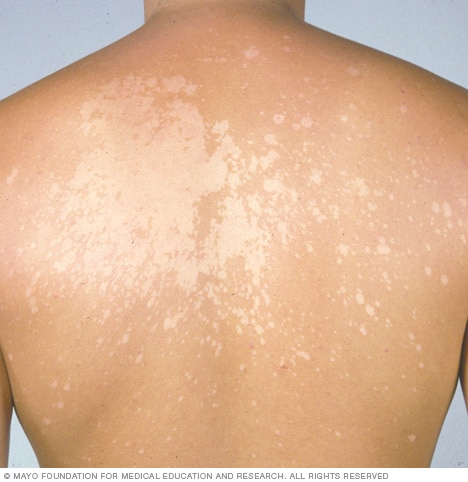Tinea versicolor
Tinea versicolor is a common fungal infection of the skin. The fungus interferes with the normal pigmentation of the skin, resulting in small, discolored patches. These patches may be lighter or darker in color than the surrounding skin and most commonly affect the trunk and shoulders.
Tinea versicolor (TIN-ee-uh vur-si-KUL-ur) occurs most frequently in teens and young adults. Sun exposure may make tinea versicolor more apparent. Tinea versicolor, which is also called pityriasis versicolor, is not painful or contagious. But it can lead to emotional distress or self-consciousness.
Antifungal creams, lotions or shampoos can help treat tinea versicolor. But even after successful treatment, skin color may remain uneven for several weeks or months. Tinea versicolor often recurs, especially in warm, humid weather.

Tinea versicolor signs and symptoms include:
- Patches of skin discoloration, usually on the back, chest, neck and upper arms, which may appear lighter or darker than usual
- Mild itching
- Scaling
When to see a doctor
See your doctor if:
- Your skin doesn't improve with self-care measures
- The fungal infection returns
- The patches cover large areas of your body
The fungus that causes tinea versicolor can be found on healthy skin. It only starts causing problems when the fungus overgrows. A number of factors may trigger this growth, including:
- Hot, humid weather
- Oily skin
- Hormonal changes
- Weakened immune system
Risk factors for tinea versicolor include:
- Living in hot, humid weather.
- Having oily skin.
- Experiencing changes in hormone levels.
To help prevent tinea versicolor from returning, your doctor can prescribe a skin or oral treatment that you use once or twice a month. You may need to use these just during warm and humid months. Preventive treatments include:
- Selenium sulfide (Selsun) 2.5 percent lotion or shampoo
- Ketoconazole (Ketoconazole, Nizoral, others) cream, gel or shampoo
- Itraconazole (Onmel, Sporanox) tablets, capsules or oral solution
- Fluconazole (Diflucan) tablets or oral solution
Your doctor can diagnose tinea versicolor by looking at it. If there's any doubt, he or she may take skin scrapings from the infected area and view them under a microscope.
If tinea versicolor is severe or doesn't respond to over-the-counter antifungal medicine, you may need a prescription-strength medication. Some of these medications are topical preparations that you rub on your skin. Others are drugs that you swallow. Examples include:
- Ketoconazole (Ketoconazole, Nizoral, others) cream, gel or shampoo
- Ciclopirox (Loprox, Penlac) cream, gel or shampoo
- Fluconazole (Diflucan) tablets or oral solution
- Itraconazole (Onmel, Sporanox) tablets, capsules or oral solution
- Selenium sulfide (Selsun) 2.5 percent lotion or shampoo
Even after successful treatment, your skin color may remain uneven for several weeks, or even months. Also, the infection may return in hot, humid weather. In persistent cases, you may need to take a medication once or twice a month to prevent the infection from recurring.
For a mild case of tinea versicolor, you can apply an over-the-counter antifungal lotion, cream, ointment or shampoo. Most fungal infections respond well to these topical agents, which include:
- Clotrimazole (Lotrimin AF) cream or lotion
- Miconazole (Micaderm) cream
- Selenium sulfide (Selsun Blue) 1 percent lotion
- Terbinafine (Lamisil AT) cream or gel
- Zinc pyrithione soap
When using creams, ointments or lotions, wash and dry the affected area. Then apply a thin layer of the product once or twice a day for at least two weeks. If you're using shampoo, rinse it off after waiting five to 10 minutes. If you don't see an improvement after four weeks, see your doctor. You may need a stronger medication.
It also helps to protect your skin from the sun and artificial sources of UV light. Usually, the skin tone evens out eventually.
You're likely to start by first seeing your family doctor or a general practitioner. He or she may treat you or refer you to a specialist in skin disorders (dermatologist).
What you can do
Preparing a list of questions beforehand can help you make the most of your time with your doctor. For tinea versicolor, some basic questions to ask your doctor include:
- How did I get tinea versicolor?
- What are other possible causes?
- Do I need any tests?
- Is tinea versicolor temporary or long lasting?
- What treatments are available, and which do you recommend?
- What side effects can I expect from treatment?
- How long will it take for my skin to return to normal?
- Can I do anything to help, such as avoid the sun at certain times or wear a specific sunscreen?
- I have other health conditions. How can I best manage them together?
- Is there a generic alternative to the medicine you're prescribing me?
- Do you have brochures or other printed material I can take home? What websites do you recommend?
What to expect from your doctor
Your doctor is likely to ask you a number of questions, such as:
- How long have you had these discolored areas on your skin?
- Have your symptoms been continuous or occasional?
- Have you had this or a similar condition in the past?
- Do the affected areas itch?
- Does anything seem to improve your symptoms?
- What, if anything, appears to worsen your symptoms?
Last Updated Jul 13, 2024
© 2024 Mayo Foundation for Medical Education and Research (MFMER). All rights reserved. Terms of Use



